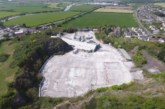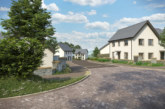The Blaenau Ffestiniog quarry in North Wales has been reopened by Welsh Slate.
Leading UK natural slate manufacturer Welsh Slate is bucking the trend and re-opening one of its quarries to meet exceptional demand for its roofing, architectural and hard landscaping/aggregate products.
Its quarry at Blaenau Ffestiniog, which originally opened in 1818 but ceased production of roofing slates 10 years ago, will now re-start, leading to the recruitment of more than 20 staff. They will help produce 25,000 roofing slates per week, rising to an anticipated 30,000 in the near future.
Seven of the staff will be based at Blaenau Ffestiniog, extracting and transporting large blocks of raw slate to Welsh Slate’s Cwt-y-Bugail quarry at Llan Ffestiniog, the highest industrial workings in the UK, three miles away. Six more staff at Llan Ffestiniog will saw and split the slate for the rivings to be dressed at the company’s main Penrhyn Quarry in Bethesda.
Roofing slates from Ffestiniog Quarry were used on such prestigious projects as Kings Cross and St Pancras railway stations, the Rijksmuseum in Amsterdam and Westerloo Town Hall in Belgium.
They were particularly popular in southern England and south Wales, as well as The Netherlands, because their lighter weight meant they were more cost effective to transport, mostly by ship. This was particularly so in the UK, where a shipping duty introduced as far back as 1795 made the thinner slate even more cost effective to transport.
Ffestiniog roofing slates are Blue Grey in colour, generally lighter in shade than Cwt-y-Bugail’s Dark Blue Grey slates, with a finer grained texture which enables than to be spilt slightly thinner and in larger formats. Although their colour is very different to Penrhyn Heather Blues, the texture is similar.
The reopening of its Blaenau Ffestiniog quarry will also enable Welsh Slate to re-establish its offering of Ffestiniog architectural products for external and internal applications such as cladding, paving, flooring, window cills, copings and fire hearths. The quarry had always continued to produce industrial minerals.
Its reopening has required a significant investment by the company, which is part of the Breedon Group, the largest independent construction materials group in the UK. Sophisticated geotechnical mapping of the site identified suitable underground chambers with minimal overburden.
This enables the existing roof of the mine to be removed to expose the slate pillar for extraction, a process that had been started by the previous owners in 1973 but was then considered untenable. The slate deposits identified by surveyors are expected to last for the foreseeable future.
Commercial director Michael Hallé said: “It’s a far cry from its peak in the 1870s when the quarry at Blaenau Ffestiniog employed more than 2,500 people and produced around 10 million slates per year. But the reopening of our Ffestiniog Quarry will improve the availability of Welsh Slate overall, with total output from the three quarries amounting to more than 100,000 slates per week.
“We are delighted we will now be able to meet the exceptional demand from both domestic and export markets for this high-quality slate. There has been a strong interest from the merchants and roofing contractors in the UK and abroad, and we look forward to seeing Ffestiniog gracing roofs again.”
He added: “The investment in reopening this quarry, to allow safe extraction of the material, was considerable, but many skilled roofing contractors, particularly in The Netherlands where our slate is of far superior quality to local slate, prefer the Ffestiniog slate.”
Last summer, Welsh Slate applied successfully for planning permission to increase the life of Penrhyn Quarry, its largest, and at one time, the world’s largest slate quarry.









